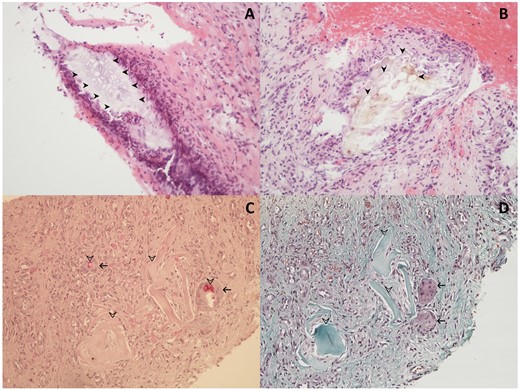-
PDF
- Split View
-
Views
-
Cite
Cite
Catarina Tenazinha, Rita Barros, Joaquim Polido-Pereira, Fernando Saraiva, Plant thorn synovitis: case report of a synovial biopsy both diagnostic and therapeutic, Rheumatology, Volume 61, Issue 5, May 2022, Pages e137–e138, https://doi.org/10.1093/rheumatology/keab568
Close - Share Icon Share
An otherwise healthy 42-year-old woman presented with pain and swelling of the right ankle that started after being accidentally stung by a date palm thorn. On examination, there was arthritis of the right tibiotalar joint. Acute-phase reactants were raised and leukocytes were normal. Histopathology of a synovial sample obtained by ultrasound-guided biopsy demonstrated a mild lymphoplasmacytic inflammatory infiltrate, granulation tissue, fibrin exudate and multinucleated giant-cells in relation with foreign matter, suggestive of vegetable matter (fig. 1). Microbiology and histochemistry (periodic acid–Schiff diastase) were negative for microorganisms. These findings were considered diagnostic of foreign body synovitis. Synovitis secondary to penetrating foreign bodies is an infrequent cause of monoarthritis and treatment requires joint washout and, in refractory cases, surgical synovectomy [1, 2]. The patient improved progressively after biopsy and has not presented signs of tibiotalar arthritis ever since. Complete extraction of the foreign body in biopsy was therefore assumed.

Histopathology of the synovial sample
(A & B) Haematoxylin and eosinstaining, amplification 100× – foreign body with cell walls, typical of vegetable matter (arrowheads). (C) Periodic acid–Schiff diastase staining, amplification 100× and (D) Masson’s trichrome staining, amplification 100× – foreign body giant cell type (arrows), in relation to foreign material, part of which is phagocytized and is partially periodic acid–Schiff diastase positive (open arrowheads).
Funding: No specific funding was received from any bodies in the public, commercial or not-for-profit sectors to carry out the work described in this article.
Disclosure statement: The authors have declared no conflicts of interest.




Comments